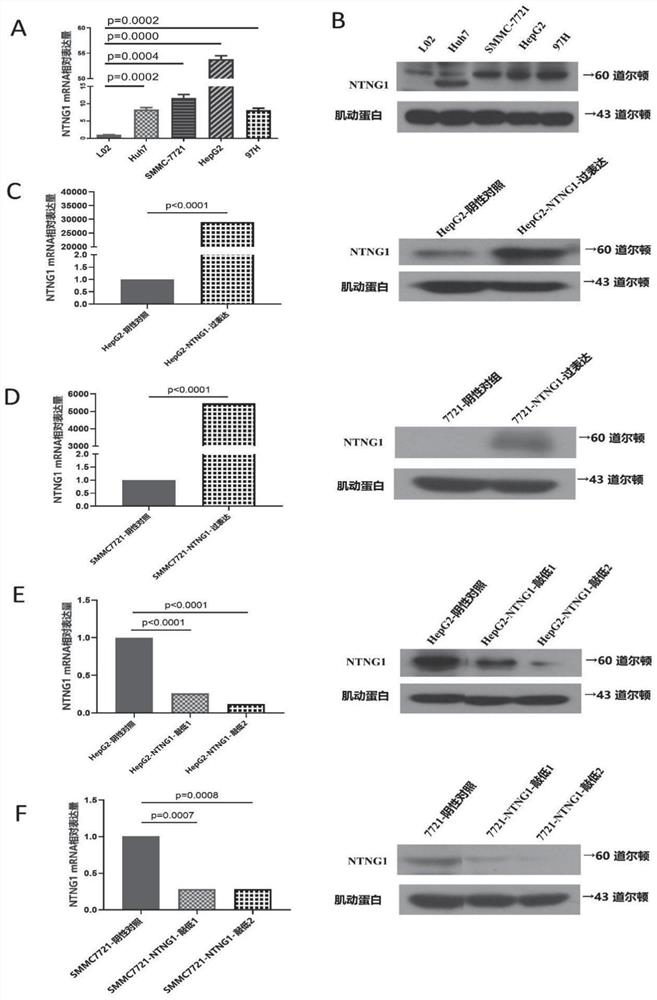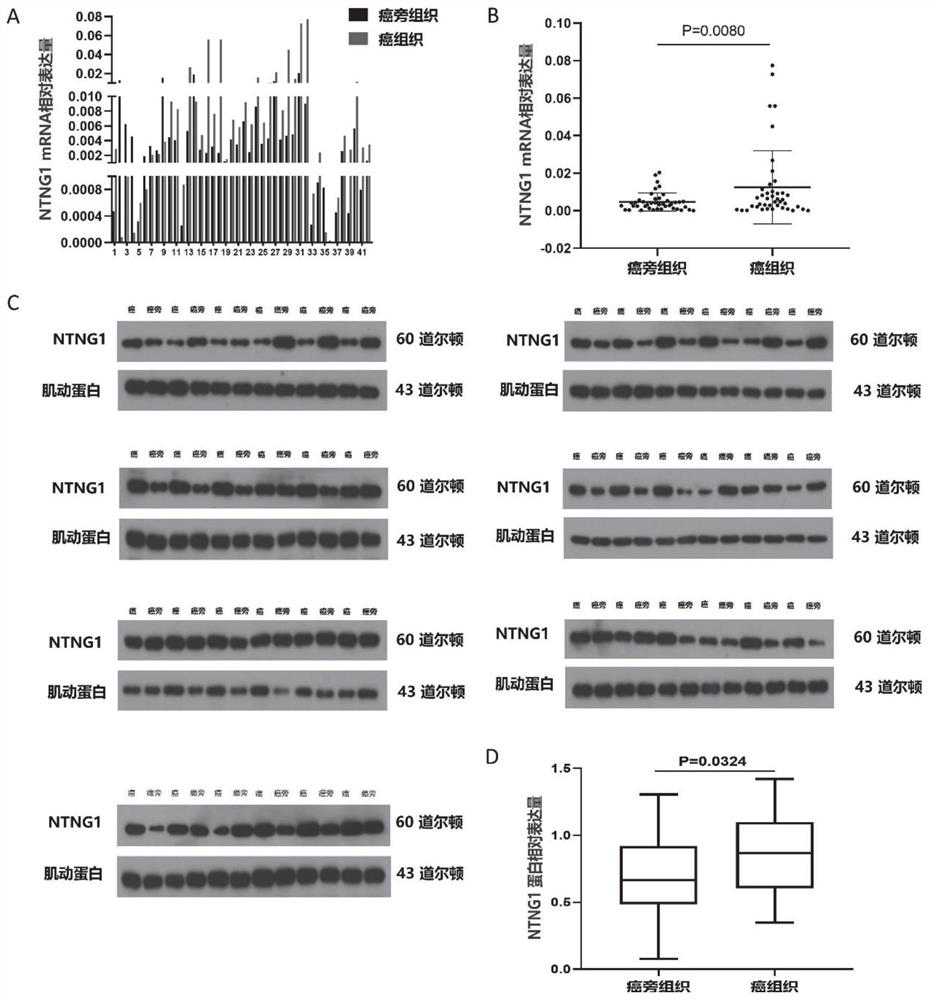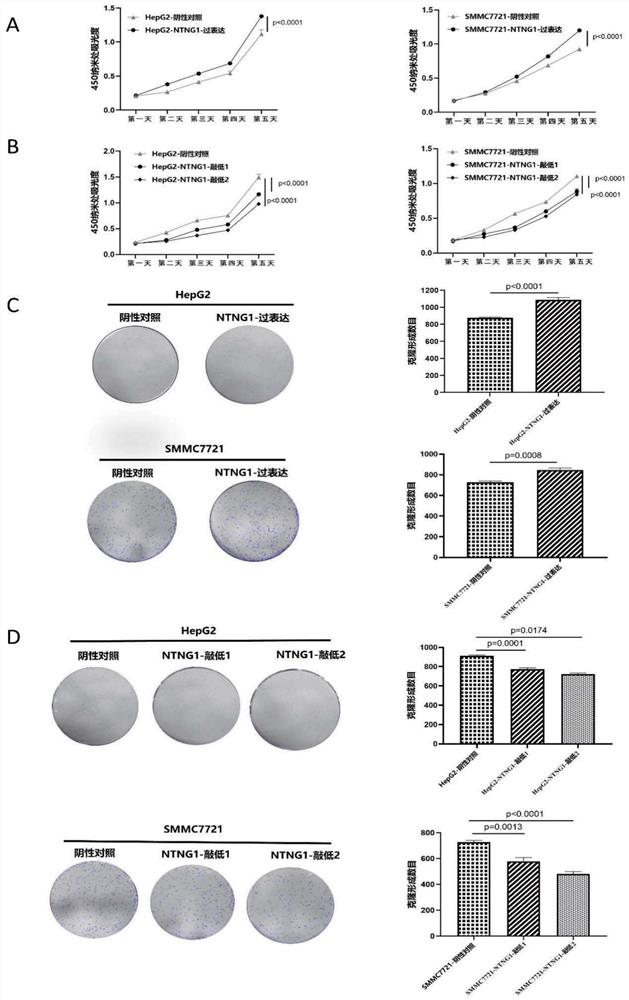Application of NTNG1 protein in preparation of reagent or kit for liver cancer diagnosis
A technology of diagnostic reagents and kits, which is applied in the field of cell biology and can solve the problems that the role of NTNG1 development has not been reported.
- Summary
- Abstract
- Description
- Claims
- Application Information
AI Technical Summary
Problems solved by technology
Method used
Image
Examples
Embodiment 2
[0095] 1.CCK-8 experiment (cytotoxicity detection)
[0096] The specific steps of the CCK-8 experiment were performed according to the manufacturer's standard protocol. Cells were diluted in serum-free medium and seeded in 96-well cell culture plates at a density of 2000 cells / well. The plate was incubated at 37°C in 5% CO 2 incubator. To measure the growth rate of the cells, replace 100 μL of the spent medium with an equal volume of fresh medium containing 10% CCK-8. Cells were then further incubated at 37°C for 3 hours. Finally, a microplate reader (5082Grodig, Tecan, Austria) was used to measure the value of cell absorbance at 450 nm. The experiment was repeated 3 times and the results were recorded.
[0097] 2. Plate colony formation experiment
[0098] Cells in the logarithmic growth phase were taken from the cells in good growth state, digested with trypsin, resuspended with medium, inoculated into six-well plates with 500 cells per well, and cultured normally for ...
Embodiment 3
[0107] Flow Cytometry
[0108] Collect the HepG2 and SMMC7721 cells of each group transfected for 48 hours, digest with EDTA-free trypsin, wash twice with PBS, add 500 μL of binding buffer to resuspend the cells, and then add 5 μL of annexin V-fluorescein isothiocyanate (FITC) and propidium iodide (PI), protected from light, incubated at room temperature for 15 min, and then detected the apoptosis rate of cells in each group on a flow cytometer (BD, USA). Then the cells were collected and fixed with 70% ethanol at 4°C for 2 hours, treated with PI (50 μg / mL) and RNase A I (100 μg / mL), incubated at 37°C in the dark for 30 minutes, and placed in a flow cytometer The changes of DNA content in cells were analyzed in each period. Experiments were repeated three times.
[0109] Conclusion: NTNG1 inhibits apoptosis and regulates cell cycle progression in human hepatocellular carcinoma cells
[0110] The uncontrolled proliferation of tumor cells caused by apoptosis and cycle regulat...
Embodiment 4
[0115] 1 Transwell cell experiment
[0116] The Transwell chamber was placed in a 24-well plate prepared with artificial basement membrane (Matrigel) matrigel in advance, placed in an environment of 37°C for 30 minutes, and a medium containing 10% fetal bovine serum was added to the lower chamber of the Transwell chamber. Add the upper chamber of Transwell to resuspend the cells of each group with serum-free DMEM high-glucose medium, 5% CO 2 , Cultivate for 48 hours at 37°C with saturated humidity. After 48 hours, the culture solution in the lower chamber was removed, the small chamber was fixed in 4% paraformaldehyde for 15 minutes, stained with 0.1% crystal violet solution for 10 minutes, dehydrated with ethanol, and the polycarbonate film was placed on a glass slide, and the high power lens ( ×200) to count the number of invasive cells. The experiment was repeated three times.
[0117] 2 Cell scratch experiment
[0118] The HepG2 and SMMC7721 cell lines that knocked dow...
PUM
 Login to view more
Login to view more Abstract
Description
Claims
Application Information
 Login to view more
Login to view more - R&D Engineer
- R&D Manager
- IP Professional
- Industry Leading Data Capabilities
- Powerful AI technology
- Patent DNA Extraction
Browse by: Latest US Patents, China's latest patents, Technical Efficacy Thesaurus, Application Domain, Technology Topic.
© 2024 PatSnap. All rights reserved.Legal|Privacy policy|Modern Slavery Act Transparency Statement|Sitemap



